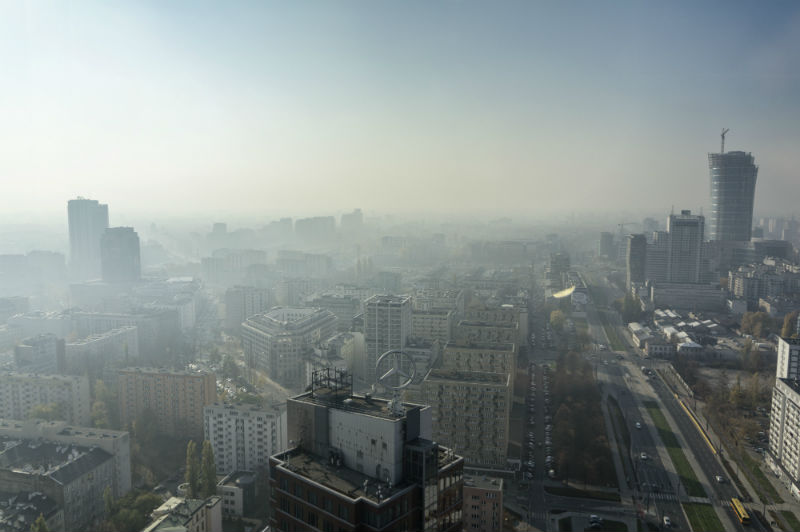Warsaw is struggling with air pollution
Scientists from the Warsaw University of Technology are developing the Warsaw Air Quality Index (WIP). It is an element of a comprehensive environment protection programme for the capital city of Warsaw, which has been announced by the end of 2016. – It should serve the residents of Warsaw as well as municipal authorities – says Artur Badyda, PhD, Eng., of the Faculty of Building Services, Hydro and Environmental Engineering of the Warsaw University of Technology, who supervises the development of the project.
Currently the data on air quality is accumulated by the Voivodeship Inspectorate of Environmental Protection. Scientists from our University are planning to act in a slightly different manner. – Among other things we want to utilise forecast models – explains Dr Badyda. – On the basis of information about the values of pollutant emissions and meteorological parameters we will be able to calculate and estimate not only the present air condition but also predict what the air is going to be like several or even a dozen hours into the future.
With regard to the above the city authorities will be able to react in advance, which is to mean that they will be able to undertake actions leading to limiting the emission of harmful substances and prepare appropriate announcements which will later be broadcast to the residents. Lately, when air quality became one of the most important topics in the capital and the rest of the country we have found out just how essential such a system would be.
More precise measurements
The contract for the realisation of the first stage of the Warsaw Air Index has been signed on 21 December 2016 by Prof. Stanisław Wincenciak, PhD, Eng., the Vice-Rector for Development of the Warsaw University of Technology and Michał Olszewski, Vice-President of the Capital City of Warsaw. The effects of the labours of our scientists will be revealed in autumn.
However, this will not mean the end of the cooperation with municipal authorities. The next step is to increase the number of devices measuring the level of pollutants in Warsaw and its vicinity. Around 100 of those devices are to be installed. – These will be devices simplified in comparison to those used by the Voivodeship Inspectorate of Environmental Protection – says Dr Badyda. – They will allow us to establish a denser measurement network in Warsaw. We will be able to identify the places in which, according to our short-term measurements, the levels of pollutants are too high.
The scientist emphasises that this solution is not aimed at competing with the activities conducted by the Voivodeship Inspectorate of Environment Protection. It is being developed to supplement their data. Numerous parties are applying, keen to take advantage of this knowledge. – I received signals that developers and companies of the construction industry in general are interested in our measurements – admits Dr Badyda. – They want to know whether their buildings are situated in zones with low or high pollutant concentrations.
The unmentioned issue
Apart from Dr Badyda other scientists of the Faculty of Building Services, Hydro and Environmental Engineering of the Warsaw University of Technology are involved in developing the project. The expert knowledge and experience of prof. Andrzej Kraszewski, PhD, Eng. is at their disposal. All IT issues are the responsibility of Mariusz Rogulski, PhD, Eng. The core of the team comprises doctoral students: Anna Gayer, Dominika Mucha and Łukasz Adamkiewicz. The project also benefits from the support of experts of the Faculty of Electrical Engineering: Bogdan Dziadak, PhD, Eng., and Łukasz Makowski, PhD, Eng.
– The group is far from a closed team – says Dr Badyda. – We will involve other collaborators from our faculty as well as other faculties of the University as necessary. We are open to cooperation. We want the design to be done right. We want Warsaw to be satisfied with our work. Then, we want to further develop the project and improve the quality of our air.
This is a great challenge. Dr Badyda points to the fact that in the capital itself we have 70 to 80 days a year when the level of suspended particulates, i.e. the main constituent of smog, is too high. What is interesting, a decade ago the number of such days amounted to more than 100, sometimes even to 150. At that time however, that was of interest only to a few people. The situation changed a few years ago, when the media took on the subject. The issue of air pollution has existed since the beginning of the industrial revolution, i.e. for more than 200 years. – In Poland we had significant problems with it before 1990 – says Dr Badyda. – High concentrations of pollutants were caused by the industry and the method of energy production. There were none or close to none exhaust fume treatment installations.
The fact that currently we are using more environment-friendly fuels and heating methods does not mean that the issue has been resolved. – In that time the number of vehicles has risen from 9 to nearly 30 million – says Dr Badyda. – As many as 140 thousand unclassified, lowest quality coal furnaces are still purchased each year in Poland. Each year the levels of the most harmful pollutants are exceeded, especially in the south of our country.
Terrifying data
Dr Badyda has analysed the manner in which air pollution translates to the number of premature deaths in Warsaw. The results are frightening. – In accordance with my estimations for 2014 there have been 2,700 of them – says the researcher.
In his research he used statistical data pertaining to respiratory and circulatory system disease and cancer incidence, related mortality rates, ratios concerning epidemiological research and information about the quality of air in Warsaw.
Dr Badyda cites other terrifying data. – The European Environment Agency announced that as many as 50 thousand people die on account of air pollution each year in Poland – he states. – This amounts to around 11–12% of all deaths in our country. For comparison – only around 3.5 thousand people die in traffic accidents.
Dr Badyda points out that it is impossible to discredit the information about traffic accident mortality rates. In contract, the deaths attributed to air pollution are widely disputed. It stems from the fact that in such cases the cause of death is impossible to be assessed with 100% certainty.
Can we afford to ignore such information?
Agnieszka Kapela
Office for Promotion and Information









